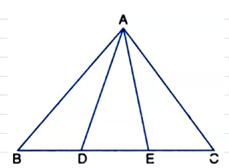Let S = {a,b,c,d,e} and R be a relation on S defined by,
R={(b,a),(b,d),(d,b),(d,d),(e,b)} ,
find the inverse of R.Solution in Bengali
The correct Answer is:R−1={(a,b),(d,b),(b,d),(d,d),(b,e)}
Step by step video, text & image solution for Let S = {a,b,c,d,e} and R be a relation on S defined by, R={(b,a),(b,d),(d,b),(d,d),(e,b)} , find the inverse of R. by Maths experts to help you in doubts & scoring excellent marks in Class 12 exams.
Topper's Solved these Questions
- BOOK - CHHAYA PUBLICATIONCHAPTER - RELATION AND MAPPING EXERCISE - Short Answer Type Question60videos
RELATION AND MAPPING
- BOOK - CHHAYA PUBLICATIONCHAPTER - RELATION AND MAPPING EXERCISE - Long Answer Type Questions72videos
RELATION AND MAPPING
- BOOK - CHHAYA PUBLICATIONCHAPTER - RELATION AND MAPPING EXERCISE - Multiple choice question28videos
RELATION AND MAPPING
- BOOK - CHHAYA PUBLICATIONCHAPTER - REAL NUMBERSEXERCISE - Exercise (Long Answer Type Questions)10videos
REAL NUMBERS
- BOOK - CHHAYA PUBLICATIONCHAPTER - RELATION AND FUNCTIONS EXERCISE - JEE Advanced Archive3videos
RELATION AND FUNCTIONS
Similar Questions
If A×B={(1,2),(3,4),(5,2),(1,4),(3,2),(5,4)}, find B×A.
02:10View SolutionFind the domain of definitions of each of the following functions :
√6−x05:48View SolutionIf (a +b, 3a - 2b) = (-9, -2), then a and b are___
03:30View SolutionDefine a rational number and prove that √2 is not rational.
01:49View SolutionThe value of cot{23∑n=1cot−1(1+n∑k−12k)}is
01:39View SolutionIn Figure DandE are two points on BC such that BD=DE=EC Show that ar(ABD)=ar(ADE)=ar(AEC)
 01:36View Solution
01:36View SolutionLet R be a relation on N×N defined by (a,b) R(c,d)⇔a+d=b+c for all (a,b),(c,d)∈N×N show that: (i) (a,b)R (a,b) for all (a,b)∈N×N (ii) (a,b)R(c,d)⇒(c,d)R(a,b)for all (a,b), (c,d)∈N×N (iii) (a,b)R (c,d)and (c,d)R(e,f)⇒(a,b)R(e,f) for all (a,b), (c,d), (e,f)∈N×N
01:37View SolutionLet R be a relation over the set NxxN and it is defined by (a,b)R(c,d)impliesa+d=b+c . Then R is
01:40View SolutionLet S = {a,b,c,d,e} and R be a relation on S defined by,
R={(b,a),(b,d),(d,b),(d,d),(e,b)} ,
find the domain01:35View SolutionLet S = {a,b,c,d,e} and R be a relation on S defined by,
R={(b,a),(b,d),(d,b),(d,d),(e,b)} ,
find the range.01:35View SolutionState which of the following sets are disjoint.
R = {a, b, c, d, e}, S = {d, e, b, c, a}03:05View SolutionA,B,D,A,E,A,R,D,A,C,B,D,B,E,B Find the frequency of A in the given data
07:10View Solutionমনে করাে, S={a,b,c,d,e} এবং S-এর ওপর একটি সম্বন্ধ R নিম্নরূপে সংজ্ঞাত, R={(b,a),(b,d),(d,b),(d,d),(e,b)}R সম্বন্ধের ক্ষেত্র নির্ণয় করাে।
04:50View Solutionমনে করাে, S={a,b,c,d,e} এবং S-এর ওপর একটি সম্বন্ধ R নিম্নরূপে সংজ্ঞাত, R={(b,a),(b,d),(d,b),(d,d),(e,b)}R সম্বন্ধের পাল্লা নির্ণয় করাে।
05:21View Solutionমনে করাে, S={a,b,c,d,e} এবং S-এর ওপর একটি সম্বন্ধ R নিম্নরূপে সংজ্ঞাত, R={(b,a),(b,d),(d,b),(d,d),(e,b)}R সম্বন্ধের বিপরীত সম্বন্ধ নির্ণয় করাে।
03:31View Solution

